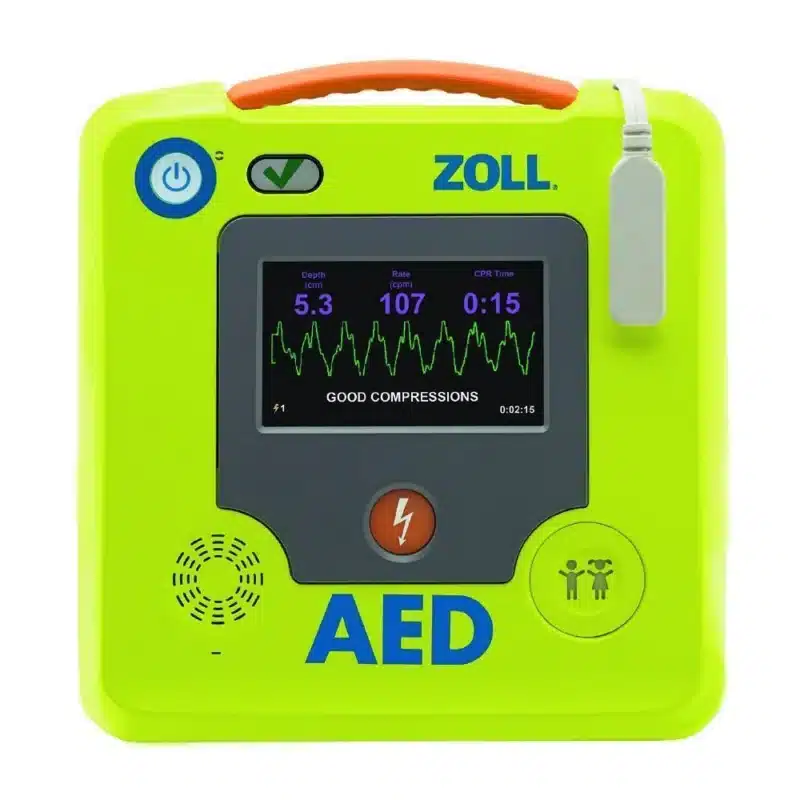No products in the cart.
AED's
Difference Between Automated External Defibrillators (AEDs) and Manual Defibrillators: A Comprehensive Overview
Defibrillators are lifesaving devices designed to restore normal heart rhythm during sudden cardiac arrest (SCA), by administering an electric shock. There are two primary kinds of defibrillators – Automated External Defibrillators (AEDs) and Manual Defibrillators; although both types aim at restarting or correcting heartbeat rhythm, their functionality, operation, use case considerations and target populations can differ considerably; we will examine their differences here as we explore AED and manual defibrillator differences; how they work as well as their portability during emergencies as we explore their differences by discussing AED and manual defibrillator differences compared with both types.
Defibrillators: An Overview

Defibrillators are used to treat life-threatening cardiac arrhythmias such as ventricular fibrillation (VF) and pulseless ventricular tachycardia (VT), both of which can lead to sudden cardiac arrest. They do so by administering an electrical shock to help reset your heart rhythm; both AEDs and manual defibrillators serve this function, although their approaches differ dramatically: AEDs are designed for easy use by anyone even those without training while manual defibrillators require professional expertise while AEDs require professional training before use whereas manual defibrillators cannot.
What Are Automated External Defibrillators (AEDs)?

Automated External Defibrillators, commonly referred to as AEDs, are portable devices designed for ease of use in public places and designed for quick response during sudden cardiac arrest events. AEDs automatically detect abnormal heart rhythms to determine whether shock therapy should be applied; voice prompts and visual instructions guide users through administering shocks should they become necessary.
One of the primary advantages of AEDs is their automatic detection feature. The device detects electrical heart activity to determine if a shock is necessary without needing user interpretation of condition; making these devices particularly helpful in situations without medical personnel present and with safety features to ensure only real shocks are administered – eliminating accidental harm to patients or themselves.
What Are Manual Defibrillators (MDF)?
Manual defibrillators are complex devices used by healthcare professionals such as paramedics, doctors and nurses. These manual defibrillators allow healthcare workers to control and administer shocks themselves manually making these machines both versatile and complex to operate; the operator needs to interpret heart rhythm patterns of patients before making this determination and manually setting energy level of shock accordingly.
Defibrillators used manually often feature ECG (electrocardiogram) monitoring capabilities as well, providing medical professionals with real-time insight into a patient’s heart electrical activity and making critical decisions quickly and accurately. Manual defibrillators have become an indispensable asset to hospitals and emergency medical settings where patient conditions need to be closely tracked – yet using one requires advanced knowledge of cardiac rhythms as well as critical decision making skills in real time.
Comparison for Automated External Defibrillators and Manual Defibrillators
Ease of Use
At their core, AEDs and manual defibrillators differ significantly in ease-of-use. AEDs have been created for accessibility by design; anyone without medical training should find using one straightforward. Voice instructions guide users step-by-step through defibrillation process – perfect for public environments where bystanders may act quickly in an emergency situation.
Manual defibrillators, on the other hand, require skilled medical personnel for optimal use. Their user must interpret each individual patient’s heart rhythm before setting shock settings based on medical expertise – making manual defibrillators much more complex to operate but more powerful when in skilled hands – than AEDs which automate much of this decision-making process. Manual defibrillators provide healthcare providers greater control of treatment.
Portability and Accessibility.
One key difference between AEDs and manual defibrillators lies in their portability and accessibility. AEDs are lightweight and easily transported to patients in distress; their lightweight build makes transport easy; these public AEDs can even be placed near high traffic public places like airports, schools or stadiums to enable quick use during emergencies such as cardiac arrest – significantly increasing chances of survival!
Manual defibrillators, on the other hand, are less portable. While they’re commonly found in ambulances and emergency medical services (EMS) vehicles, their setup requires longer. Instead, this device should typically be utilized by trained healthcare providers who can monitor patient conditions more closely compared to manual defibrillators which tend to be larger devices with complex settings that make them unsuited for immediate public usage.
Cost Considerations
Defibrillator costs vary considerably, with AEDs generally more cost-effective than manual defibrillators. They generally range between $1,000 and $2,500 in cost depending on brand and features; making AEDs ideal choices for businesses, public institutions and organizations looking to provide lifesaving equipment at reduced upkeep costs than manual models.
Manual defibrillators tend to cost between $5,000 and $10,000 or more and their higher price reflects their advanced features such as diagnostic features and shock settings customization. Given this higher expense, manual defibrillators tend to be reserved for healthcare facilities in which such features are necessary.
Effectiveness in Emergency Situations
Both AEDs and manual defibrillators can be extremely useful tools in treating sudden cardiac arrest; their success relies on both their user’s situation and that of others around them. AEDs may prove particularly helpful when used early upon cardiac arrest to increase survival rates dramatically – studies have indicated this through using AEDs within minutes to improve survival rates significantly – with their simplicity enabling bystanders to act swiftly, which is key when responding quickly in an emergency situation.
Manual defibrillators, however, are most effective when used by trained healthcare providers in hospital settings. Healthcare providers can utilize manual defibrillators to treat more complex cardiac arrhythmias tailored specifically for each individual. Furthermore, professionals have more control over outcomes due to being able to track heart rhythm in real-time while simultaneously altering shock intensity based on real time monitoring of patient hearts.
Training Requirements
Another major difference between AEDs and manual defibrillators lies in their respective training requirements. An AED has been specifically designed to be user-friendly, so its training requirements may differ considerably from manual defibrillators. With AEDs designed as user-friendly devices that require only minimal instruction compared to CPR (cardiopulmonary resuscitation) courses which include AED use instruction often making these accessible to first responders, teachers, security personnel or the general public alike. Even someone without medical training could confidently operate an AED in case of emergencies!
However, using a manual defibrillator requires significant medical training. Paramedics, nurses, and doctors all undergo advanced training in cardiac life support and defibrillation techniques; courses like Advanced Cardiac Life Support (ACLS) provide students with skills for reading heart rhythms accurately while managing defibrillator settings and administering shocks safely and effectively.
Conclusion
As previously discussed, selecting between an AED or manual defibrillator depends upon its intended context and the level of training of those operating it. AEDs are ideal for public settings or first responders without extensive medical knowledge as they’re portable, easy-to-use defibrillators which work quickly during emergencies; on the other hand, manual defibrillators offer greater control and diagnostic capability but require trained healthcare providers for use.
Both types of defibrillators play an essential part in saving lives during sudden cardiac arrest, with AEDs designed for rapid treatment in out-of-hospital environments while manual defibrillators offer more tailored, precision care in clinical environments. Understanding their differences allows users to deploy them effectively when appropriate for patients’ specific circumstances – ultimately leading to positive patient outcomes and success rates.






